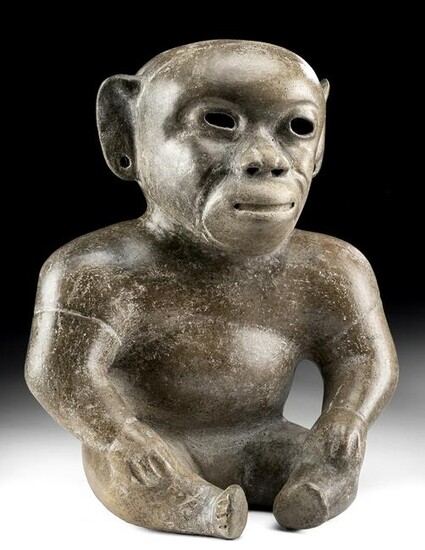Colima Pottery Hunchback Dwarf Figure
Pre-Columbian, West Mexico, Colima, ca. 300 BCE to 300 CE. A hollow-built and highly burnished pottery dwarf figure of an unusual stylistic presentation bearing an almost simian-style face with a body covered in red-brown slip. The figure sits with attenuated legs curled in front of the body, holds both arms atop the knees, has a slightly distended abdomen beneath stocky shoulders, and presents with a forward lean due mostly to the dramatically curved hump along the back. The perplexing face bears open ovoid eyes above flared nostrils, deep nasolabial folds that flank that puffy, jowl-like lips, a bulging forehead, and a pair of vertically pointed ears with pierced lobes meant for additional ornamentation. Size: 8.625" W x 10.25" H (21.9 cm x 26 cm)
Hunchback and dwarf individuals were popular motifs in Colima sculpture - indeed, they heavily outnumber portrayals of women (and some have theorized that this relates to their relatively high social status in the society). Some scholars attribute the hunched back in West Mexican shaft tomb culture to a particular form of tuberculosis; the protruding shoulders of this example may be part of the figure's deformity or the result of an emaciated state.
Colima, located on Mexico's southwestern coast, was during this time part of the shaft tomb culture, along with neighbors to the north in Jalisco and Nayarit. In this culture, the dead were buried down shafts - 3 to 20 meters deep - that were dug vertically or near vertically through the volcanic tuff that makes up the geology of the region. The base of the shaft would open into one or more horizontal chambers with a low ceiling. These shafts were almost always dug beneath a dwelling, probably a family home, and seem to have been used as family mausoleums, housing the remains of many related individuals. This is a figure made to be placed inside those mausoleums, perhaps to mediate between the worlds of the living and the dead.
Provenance: ex-Barakat Gallery, Beverly Hills, California, USA, acquired prior to 2000
All items legal to buy/sell under U.S. Statute covering cultural patrimony Code 2600, CHAPTER 14, and are guaranteed to be as described or your money back.
A Certificate of Authenticity will accompany all winning bids.
We ship worldwide to most countries and handle all shipping in-house for your convenience.
#155895
Condition Report: Head professionally repaired from a few large pieces and reattached to neck, with nearly invisible resurfacing and overpainting along break lines. Abrasions and nicks to legs, arms, body, and head, with fading to original pigment, and encrustations within some recessed areas. Nice earthen deposits throughout.
View it on
Sale price
Estimate
Time, Location
Auction House
Pre-Columbian, West Mexico, Colima, ca. 300 BCE to 300 CE. A hollow-built and highly burnished pottery dwarf figure of an unusual stylistic presentation bearing an almost simian-style face with a body covered in red-brown slip. The figure sits with attenuated legs curled in front of the body, holds both arms atop the knees, has a slightly distended abdomen beneath stocky shoulders, and presents with a forward lean due mostly to the dramatically curved hump along the back. The perplexing face bears open ovoid eyes above flared nostrils, deep nasolabial folds that flank that puffy, jowl-like lips, a bulging forehead, and a pair of vertically pointed ears with pierced lobes meant for additional ornamentation. Size: 8.625" W x 10.25" H (21.9 cm x 26 cm)
Hunchback and dwarf individuals were popular motifs in Colima sculpture - indeed, they heavily outnumber portrayals of women (and some have theorized that this relates to their relatively high social status in the society). Some scholars attribute the hunched back in West Mexican shaft tomb culture to a particular form of tuberculosis; the protruding shoulders of this example may be part of the figure's deformity or the result of an emaciated state.
Colima, located on Mexico's southwestern coast, was during this time part of the shaft tomb culture, along with neighbors to the north in Jalisco and Nayarit. In this culture, the dead were buried down shafts - 3 to 20 meters deep - that were dug vertically or near vertically through the volcanic tuff that makes up the geology of the region. The base of the shaft would open into one or more horizontal chambers with a low ceiling. These shafts were almost always dug beneath a dwelling, probably a family home, and seem to have been used as family mausoleums, housing the remains of many related individuals. This is a figure made to be placed inside those mausoleums, perhaps to mediate between the worlds of the living and the dead.
Provenance: ex-Barakat Gallery, Beverly Hills, California, USA, acquired prior to 2000
All items legal to buy/sell under U.S. Statute covering cultural patrimony Code 2600, CHAPTER 14, and are guaranteed to be as described or your money back.
A Certificate of Authenticity will accompany all winning bids.
We ship worldwide to most countries and handle all shipping in-house for your convenience.
#155895
Condition Report: Head professionally repaired from a few large pieces and reattached to neck, with nearly invisible resurfacing and overpainting along break lines. Abrasions and nicks to legs, arms, body, and head, with fading to original pigment, and encrustations within some recessed areas. Nice earthen deposits throughout.



